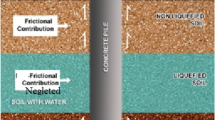Abstract
In light of the disastrous the 2011 Tohoku Pacific Earthquake, the government of Japan has conducted studies to revise the seismic design code, and elevated peak ground accelerations have been adopted. Consequently, revisions on existing design to comply with the updated code are required for public projects that are still undergoing. The design safety needs to be reassessed, and implementation of strengthening measures is required if deemed necessary. For liquefaction countermeasures, ground treatment techniques that could increase the density of soils are often the preferable alternatives. The treatment usually increases the in situ SPT-N or CPT-qc values, which in turn would increase the resistance of soil against liquefaction. For many public infrastructures in Japan supported by bored piles embedded partly or entirely in sandy soils, reevaluation of design safety against soil liquefaction would be required. In an assessment of possible retrofitting countermeasures for an infrastructure foundation, ground treatment has been considered. In this case study, effect of ground treatment on response of piles in liquefiable soils was investigated with numerical analyses using FLAC. Results provide insights into this ground treatment effect and useful information for consideration in future design or decision making.









Similar content being viewed by others
References
Adalier K, Elgamal AW, Martin GR (1998) Foundation liquefaction countermeasures for earth embankments. J Geotechn Geoenviron Eng 124(6):500–517
Akin MK, Kramer SL, Topal T (2011) Empirical correlations of shear wave velocity (Vs) and penetration resistance (SPT-N) for different soils in an earthquake-prone area (Erbaa-Turkey). Eng Geol 119(1):1–17
Bolton Seed H, Tokimatsu K, Harder LF et al (1985) Influence of SPT procedures in soil liquefaction resistance evaluations. J Geotech Eng 111(12):1425–1445
Cooke HG, Mitchell JK (1999) Guide to remedial measures for liquefaction mitigation at existing highway bridge sites. Buffalo, New York
Finn WDL (2015) 1st Ishihara Lecture: an overview of the behavior of pile foundations in liquefiable and non-liquefiable soils during earthquake excitation. Soil Dyn Earthq Eng 68:69–77
Hatanaka M, Suzuki Y, Miyaki M et al (1987) Some factors affecting the settlement of structures due to sand liquefaction in shaking table tests. Soils Found 27(1):94–101
Huang Y, Wen Z (2015) Recent developments of soil improvement methods for seismic liquefaction mitigation. Nat Hazards 76(3):1927–1938
Iwasaki T, Arakawa T, Tokida KI (1984) Simplified procedures for assessing soil liquefaction during earthquakes. Int J Soil Dyn Earthq Eng 3(1):49–58
Juang CH, Yuan H, Lee DH et al (2003) Simplified cone penetration test-based method for evaluating liquefaction resistance of soils. J Geotech Geoenviron Eng 129(1):66–80
Liu L, Dobry R (1997) Seismic response of shallow foundation on liquefiable sand. J Geotech Geoenviron Eng 123(6):557–567
Nutt RV (1996) Improved seismic design criteria for California bridges: provisional recommendations
Smith RE (2011) Prefab architecture: a guide to modular design and construction. Wiley, London
Stark TD, Olson SM (1995) Liquefaction resistance using CPT and field case histories. J Geotech Eng 121(12):856–869
Tokimatsu K, Yoshimi Y (1983) Empirical correlation of soil liquefaction based on SPT N-value and fines content. Soils Found 23(4):56–74
Tokimatsu K, Tamura S, Suzuki H et al (2012) Building damage associated with geotechnical problems in the 2011 Tohoku Pacific Earthquake. Soils Found 52(5):956–974
Turner BJ, Brandenberg SJ, Stewart JP (2016) Case study of parallel bridges affected by liquefaction and lateral spreading. J Geotech Geoenviron Eng 142:05016001
Zekri A, Ghalandarzadeh A, Ghasemi P et al (2015) Experimental study of remediation measures of anchored sheet pile quay walls using soil compaction. Ocean Eng 93:45–63
Author information
Authors and Affiliations
Corresponding author
Rights and permissions
About this article
Cite this article
Chen, Y. Study of Ground Treatment on Improvement of Pile Foundation Response in Liquefiable Soils. Geotech Geol Eng 35, 2219–2226 (2017). https://doi.org/10.1007/s10706-017-0239-3
Received:
Accepted:
Published:
Issue Date:
DOI: https://doi.org/10.1007/s10706-017-0239-3




